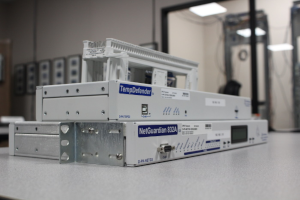Check out our White Paper Series!
A complete library of helpful advice and survival guides for every aspect of system monitoring and control.
1-800-693-0351
Have a specific question? Ask our team of expert engineers and get a specific answer!
Sign up for the next DPS Factory Training!

Whether you're new to our equipment or you've used it for years, DPS factory training is the best way to get more from your monitoring.
Reserve Your Seat TodayWhen you're managing infrastructure - especially telecom or utility networks - there's one thing that can kill momentum faster than any technical hurdle: waiting.
The broad definition of time spent "waiting" includes:
One of our clients found themselves in exactly that position. With major internal shifts, an acquisition, and external delays, their network monitoring upgrades sat on hold for months (even though they knew their systems needed replacement).
Once they received their funding green light (and considered the looming end-of-year deadline), the race was on. They had to modernize their monitoring infrastructure quickly - without losing sight of their other high-priority projects.
Let's go over how that project unfolded, what worked, and how you can replicate their success for your own network - especially if you've got backlogged upgrades that just have to get done before the end of the year.

This client, like many others in the industry, had a mix of older and newer equipment. Their monitoring stack included aging NetGuardian G3 and G4 units, along with a legacy T/Mon master station that was still limping along, but well overdue for an upgrade.
Unfortunately, just when they were planning to make progress on their monitoring projects, things outside their control threw a wrench in the gears:
With that level of activity, it's easy to see how monitoring fell off the radar.
However, ignoring monitoring creates a hidden cost.
Without updated gear, their teams had limited visibility into these critical network changes. Without alarm data from newer sites, and with older RTUs missing modern protocol support (like SNMPv3), there were gaps in their situational awareness.
And with end-of-year reporting and accountability getting closer and closer, those gaps were becoming unacceptable.
To clarify, the equipment they had was solid for its time. DPS RTUs - especially NetGuardian models from the G3 and G4 series - were designed for long-term use. Many of them have been running for 10+ years in the field with minimal maintenance.
But just because something still works doesn't mean it meets today's standards.
Here were some of the key limitations they faced with their existing setup:
This client knew that deploying new RTUs and a modern T/Mon would solve these issues. But with everything else going on - equipment cutovers, new WISP integration, and BEAD prep - how to tackle the monitoring side without bogging down the rest of the team was a major challenge.
This client's ideal outcome was clear:
To put it another way: they needed a turnkey monitoring upgrade that wouldn't drag them into endless decision-making, confusion, or rework. The new system had to be fast, smart, and budget-conscious.
Once this client resumed conversations with DPS, things started moving quickly.
We immediately got to work:
During our first call, we listened carefully. Their top priorities weren't just "get new gear." They had a very specific timeline:
We used this info to anchor every decision moving forward.
When we reviewed the previous sensor loadout, we noticed one airflow sensor listed that didn't quite meet their requirements.
We swapped it for a D-wire Airflow Sensor. This sensor offers the same functions with better integration, and it has a much lower cost.
That one change saved hundreds of dollars and made sure they weren't paying for overkill.
T/Mon is built in-house at DPS, using a combination of our own metal fabrication and commercial-grade Linux server components. We don't face long component lead times like some other vendors.
We quoted the lead time at 30 days, but we told the client they could realistically expect 2-3 weeks from PO to shipment.
This schedule was going to work. If they submitted a PO within a week of receiving their early September quote, they'd have plenty of time to deploy by October - well ahead of the December deadline.
We bundled the T/Mon upgrade, NetGuardian replacements, and sensor changes into a single PDF proposal. This made it easy for them to:
This kind of thoughtful documentation means no back-and-forth spreadsheets or confusion. You just get one clear document that moves the process forward.
Our sales engineer stayed in direct contact with the client and their teammates, even as new people joined the conversation down the line.
When one stakeholder apologized for "coming in late (on the project calendar)," we reassured them that DPS always provides a clear point of contact - and backup support from HQ if needed.
That kind of personal service is what helps overloaded clients breathe easier.
By the end of the call, this client had:
Now, with DPS handling the monitoring side, they could stay focused on their equipment cutovers, new WISP site integrations, and BEAD rollout strategy - without dropping the ball on alarm visibility.
You are not alone if:
Our team at DPS works with clients in exactly your situation - telcos, utilities, railways, and government agencies across the U.S. and beyond.
We've seen what happens when monitoring is put off too long:
It doesn't have to be that way.
Even if you're not 100% sure what you need yet, the first step is simple:
Call me at 559-454-1600
Email sales@dpstele.com
You'll get on the phone with a real person who will:
You can also ask about T/Mon tours, product demos, or success stories from companies like yours.
If you've got new sites coming online, vendor transitions underway, or BEAD projects approved - it's time to make sure your monitoring keeps up.
Don't let legacy gear hold you back. Don't let another year slip by without a plan.
We'll help you build one - fast.
Let's talk. Call 559-454-1600 or email sales@dpstele.com.
We'll help you finish strong and set your network up for a smarter 2026 and beyond.

Andrew Erickson
Andrew Erickson is an Application Engineer at DPS Telecom, a manufacturer of semi-custom remote alarm monitoring systems based in Fresno, California. Andrew brings more than 18 years of experience building site monitoring solutions, developing intuitive user interfaces and documentation, and opt...